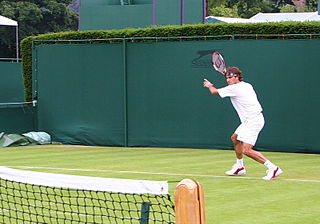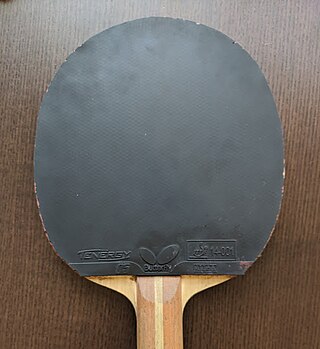
Tennis is a racket sport that is played either individually against a single opponent (singles) or between two teams of two players each (doubles). Each player uses a tennis racket strung with a cord to strike a hollow rubber ball covered with felt over or around a net and into the opponent's court. The object of the game is to manoeuvre the ball in such a way that the opponent is not able to play a valid return. The player unable to return the ball validly will not gain a point, while the opposite player will.

Table tennis is a racket sport derived from tennis but distinguished by its playing surface being atop a stationary table, rather than the court on which players stand. Either individually or in teams of two, players take alternating turns returning a light, hollow ball over the table's net onto the opposing half of the court using small rackets until they fail to do so, which results in a point for the opponent. Play is fast, requiring quick reaction and constant attention, and is characterized by an emphasis on spin, which can affect the ball's trajectory more than in other ball sports.
A volley in tennis is a shot in which the ball is struck before it bounces on the ground. Generally a player hits a volley while standing near the net, although it can be executed farther back, in the middle of the tennis court, or even near the baseline. The word derives from M. French volée meaning flight.
In tennis, a grip is a way of holding the racquet in order to hit shots during a match. The three most commonly used conventional grips are: the Continental, the Eastern and the Semi-Western. Most players change grips during a match depending on what shot they are hitting.

The forehand in tennis and other racket sports such as table tennis, squash and badminton is a shot made by swinging the racket across one's body with the hand moving palm-first. In tennis, except in the context of the phrase forehand volley, the term refers to a type of groundstroke—a stroke in which the ball has bounced before it is struck. It contrasts with the backhand, the other type of groundstroke. For a right-handed player, the forehand is a stroke that begins on the right side of the body, continues across the body as contact is made with the ball, and ends on the left side of the body. It is considered the easiest shot to master, perhaps because it is the most natural stroke. Beginners and advanced players often have better forehands than any other shots and use it as a weapon.

The backhand is a shot used in most racket sports, such as tennis, table tennis and pickleball, where the back of the hand precedes the palm when swinging the racket. Except in the phrase backhand volley, the term refers to a groundstroke. It contrasts with the forehand stroke, where the palm precedes the back of the hand. The term is also used in other sports where a similar motion is employed, such as throwing a sport disc.
In racket sports a groundstroke, or ground stroke, refers to a forehand or backhand shot that is executed after the ball has bounced on the court. The term is commonly used in the sports of tennis and pickleball, and is counter to a volley shot which is taken before the ball has bounced. Groundstrokes in tennis are usually hit from the back of the court, around the baseline.

A lob in tennis involves hitting the ball high and deep into the opponent's court. It can be used as an offensive or defensive weapon.
A drop shot is a shot in some racket sports in which the ball is hit relatively softly, sometimes with topspin or backspin, so that it lands just over and close to the net. A well-placed and well-timed drop shot will make it difficult for the opposing player to hit an aggressive or offensive shot in return. The most successful drop shots will not allow the opponent to hit the ball back at all.
In tennis, there are a variety of types of shots which can be categorized in various ways. The grip you place on will help you have different types of shots, the lower your grip means that the ball is most likely going to be a ground stroke. According to William T. Tilden, "All tennis strokes, should be made with the body' at right angles to the net, with the shoulders lined up parallel to the line of flight of the ball." The serve is the opening shot of a point. Groundstrokes are hit after the ball has already bounced, and can be either forehands or backhands depending on which direction the racket is swung relative to the body. A lob is a groundstroke hit well over the head of an opponent who is positioned at the net. A passing shot is a groundstroke that is hit out of reach of an opponent at the net far to his left or right. A cross-court shot is a shot hit from the left side of one player's court to the left side of the other player's court, so that it crosses the lengthwise centerline of the court. A down-the-line shot is one that is hit more or less parallel to, and near to, one of the sidelines, so that it never crosses the centerline.
This page is a glossary of tennis terminology.
Players use different strategies while playing tennis to enhance their own strengths and exploit their opponent's weaknesses in order to gain the advantage and win more points.
Table tennis is unique among racket sports in that it supports a wide variety of playing styles and methods of gripping the racket, at even the highest levels of play. This article describes some of the most common table tennis grips and playing styles seen in competitive play. The playing styles listed in this article are broad categories with fuzzy boundaries, and most players will possess some combination of these styles while leaning towards a "favorite". Many advanced players will also add some "special" shots of their own.

In ball sports, topspin or overspin is a property of a ball that rotates forwards as it is moving. Topspin on a ball propelled through the air imparts a downward force that causes the ball to drop, due to its interaction with the air. Topspin is the opposite of backspin.

In sports, backspin or underspin refers to the reverse rotation of a ball, in relation to the ball's trajectory, that is imparted on the ball by a slice or chop shot. Backspin generates an upward force that lifts the ball. While a normal hit bounces well forward as well as up, backspin shots bounce higher and less forward. Backspin is the opposite of topspin.
Tennis games are often used to help players of all abilities to practice the different strokes involved in tennis. The number of participants needed varies from as few as two players to as many players as can fit on a tennis court. These games are often used by coaches and other tennis instructors to help teach the basic skills of tennis.a substitute shall be allowed to field for any player who may during the match be incapacitated illness or injury, but not for any reason without the consent of the opposing captain.

Final Match Tennis (ファイナルマッチテニス) is a 1991 tennis video game that was developed and published by Human Entertainment exclusively for the PC Engine.

Table tennis rubber is a type of rubber used as covering on a racket in table tennis. Modern table tennis rubber is usually composed of two layers: a layer of foam ("sponge") underneath and a layer of actual rubber on the surface. There are four common types of table tennis rubbers: short pips, long pips, antispin, and inverted. The thickness and density of the sponge layer underneath also affects how the rubber will handle the ball.
This glossary provides definitions and context for terminology related to, and jargon specific to, the sport of pickleball. Words or phrases in italics can be found on the list in their respective alphabetic sections.








